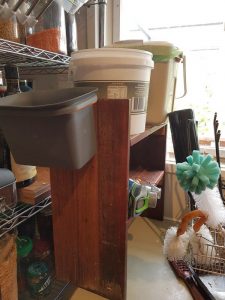Our kitchen sink area
Lucinda Flynn, from Hurstbridge, is the owner of Going Green Solutions, a local company that sells eco-products.
When you use re-usable packaging, drink bottles, recycle everything you can, cook lots of your own food and buy in bulk, you’ll notice that your kitchen develops a much more complex set of needs than the conventional kitchen.
For example, how to dry your bottles and silicone wraps? How to dispense of bulk olive oil? Where to conveniently collect all those little bits of metal and aluminium so they can be recycled?
Here are some of the ways that my family have found work for us – and I hope that they might give you some ideas and inspiration!
| 1. The first thing you might notice about our kitchen sink area is that it extends way beyond the sink and dish rack – we have too many things to wash, drain, store and access easily. The metal dish rack is a great design, but we’ve added several other parts to it to make it more functional for us. |  |
|
| 2. An extra metal basket that we found at the op-shop is fastened on to the main rack, as a great spot to hold bottles brushes, nailbrush and sundries. |  |
|
| 3. The bottom section of our dish rack is the perfect place to dry off lids and smaller bits and pieces. |  |
|
| 4. An old strainer hangs from a hook on the wall, giving us a great spot to drain cutlery and cooking utensils. It drains straight into the sink. |  |
|
| 5. Another great op-shop score was these black ‘things’ that work perfectly to dry bottles of all shapes and sizes. We’ve connected them to the dish rack with cable ties and use them constantly. |  |
|
|
6. A little wooden shelf sits just to the left of the dish rack and houses the chook bucket and compost bin on the top plus drink bottles in the middle. Attached to the side is a bucket where we put all our little metal and aluminium scraps. The little bucket has hooks that allow it to hang from the shelf, and is designed as a compost collection bucket, but we quickly discovered that it is way too small to collect our kitchen scraps and, for us, this is a much better use for it. Whenever I get an empty steel tin (for example, a soup tin), I stuff it with bottle tops and other small bits of metal, bend the top over, and throw it in the recycle bin. With aluminium, I wait until we have an empty aluminium dog food container and then fill it with all the little bits of aluminium and, again, throw it in the recycle bin. The reason that I do this is that, if we put tiny bits of metal into the recycle bin they are too small to be collected in the right waste stream, but larger pieces can easily be collected and recycled. |
 |
 |
|
7. Next is these awesome white hangers that I found on the op-shop – I wish I could tell you what they are actually meant to be so you could find some for yourself. I even did a google search but could not find anything that resembled them. They hang from our metal shelf next to the kitchen sink and each has 5 x long ‘arms’ that stand up. They are perfect for drying out silicone wraps, wax wraps, bottles, ziplock bags and anything else light that needs to drain well. They work well for bottles too. |
 |
 |
| 8. This hanging rack is in constant use, hanging all our colanders, mixing bowls and silicone food covers so that they are super easy to grab in a flash. |  |
|
| 9. This three-tier glass shelving set is really handy to store bits and pieces from the garden that are in high rotation. Each night, when my husband goes to cook, he can see what has just been picked and needs using. This one sits on the kitchen bench where he cooks. |  |
|
| 10. Do you buy your olive and veggie oil in bulk? If you do, you’ll need a bottle to decant it into and a way to pour it. The rear bottle in this image has a fantastic metal pourer that we got from the Artisans Botega (Brunswick). They have all sorts of items for DIY anything and everything. I believe that this pourer might be for pouring spirits, but it works great for olive oil too. The front bottle just has a silicone bottle stopper on it to keep the dust out. |  |
|

Oh wow, I can so relate to Lucinda’s kitchen! Bits and pieces all around and nothing like the magazine photos where the only items visible are an artfully placed vase and bowl of manicured fruit! I’m forever drying plastic bags for re-use (but I peg them on a tree branch just outside my kitchen) and there’s always an assortment of cans and containers being washed so they go into the recycle stream clean. I drape my silicon wrap inelegantly on the dish drainer until I’m frustrated and shove it into the cupboard (does anyone have suggestions for how to store them?) and fold little bits of aluminium foil into a soft drink until it’s full. Thanks for sharing these useful tips and to also show what real kitchens look like 🙂
Kathleen – Frankston